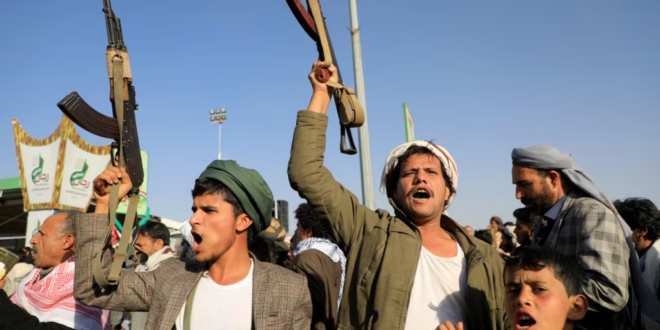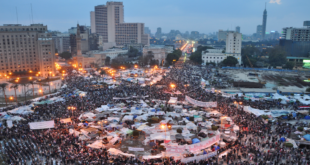It is not only missiles that are being lobbed as U.S. and U.K. air strikes aim to stop the Iran-backed Huthi rebels in Yemen from targeting ships in a key global trade route — mutual threats of continued attacks are flying around, too.
The question is how far each side might go in carrying out their warnings without drawing Tehran into a broader Middle East conflict in defense of the Huthis, whose sustained attacks on maritime shipping in the Red Sea and Gulf of Aden led to its redesignation as a terrorist organization by Washington last week.
“Our aim remains to de-escalate tensions and restore stability in the Red Sea,” the United States and the United Kingdom said in a joint statement following their latest round of air strikes on Huthi targets in Yemen on January 21. “But let us reiterate our warning to [the] Huthi leadership: we will not hesitate to defend lives and the free flow of commerce in one of the world’s most critical waterways in the face of continued threats.”
The Huthis responded with vows to continue their war against what they called Israel’s “genocide” of the Palestinian people in the Gaza Strip.
“The American-British aggression will only increase the Yemeni people’s determination to carry out their moral and humanitarian responsibilities toward the oppressed in Gaza,” said Muhammad al-Bukhaiti, a senior Huthi political official.
“These attacks will not go unanswered and unpunished,” said Huthi military spokesman Yahya Saree.
On cue, the two sides clashed again on January 24 when the Huthis said they fired ballistic missiles at several U.S. warships protecting U.S. commercial vessels transiting the Bab al-Mandab Strait off the coast of Yemen. U.S. Central Command said three anti-ship missiles were fired at a U.S.-flagged container ship and that two were shot down by a U.S. missile destroyer while the third fell into the Gulf of Aden.
With the stage set for more such encounters, Iran’s open backing and clandestine arming of the Huthis looms large. While continuing to state its support for the Huthis, Tehran has continued to deny directing their actions or providing them with weapons. At the same time, Iran has showcased its own advanced missile capabilities as a warning of the strength it could bring to a broader Middle East conflict.
The United States, emphasizing that the goal is to de-escalate tensions in the region, appears to be focusing on preventing the Huthis from obtaining more arms and funding. In addition to returning the Huthis to its list of terrorist groups, Washington said on January 16 that it had seized Iranian weapons bound for the Huthis in a raid in the Arabian Sea.
The United States and United Kingdom also appear to be focusing on precision strikes on the Huthis’ military infrastructure while avoiding extensive human casualties or a larger operation that could heighten Iran’s ire.
On January 24, the Pentagon clarified that, despite the U.S. strikes in Yemen, “we are not at war in the Middle East” and the focus is on deterrence and preventing a broader conflict.
“The United States is only using a very small portion of what it’s capable of against the Huthis right now,” said Kenneth Katzman, a senior adviser for the New York-based Soufan Group intelligence consultancy, and expert on geopolitics in the Middle East.
Terrorist Designation
The effectiveness of Washington’s restoration on January 17 of the Huthis’ terrorist organization label and accompanying U.S. sanctions — which was removed early last year in recognition of the dire humanitarian situation in Yemen and to foster dialogue aimed at ending the Yemeni civil war involving the Huthis and the country’s Saudi-backed government forces — is “marginal,” according to Katzman.
“They don’t really use the international banking system and are very much cut off,” Katzman said. “They get their arms from Iran, which is under extremely heavy sanctions and is certainly not going to be deterred from trying to ship them more weapons by this designation.”
But the strikes being carried out by the United States and the United Kingdom, with the support of Australia, Bahrain, Canada, and the Netherlands, are another matter.
The January 21 strikes against eight Huthi targets — followed shortly afterward by what was the ninth attack overall — were intended to disrupt and degrade the group’s capabilities to threaten global trade. They were a response to more than 30 attacks on international and commercial vessels since mid-November and were the largest strikes since a similar coalition operation on January 11.
Such strikes against the Huthis “have the potential to deter them and to degrade them, but it’s going to take many more strikes, and I think the U.S. is preparing for that,” Katzman said. “You’re not going to degrade their capabilities in one or two volleys or even several volleys, it’s going to take months.”
The Huthis have significant experience in riding out aerial strikes, having been under relentless bombardment by a Saudi-led military collation during the nine-year Yemeni civil war, in which fighting has ended owing to a UN-brokered cease-fire in early 2022 that the warring parties recommitted to in December.
“They weathered that pretty well,” said Jeremy Binnie, a Middle East defense analyst with the global intelligence company Janes.
“On the battlefield, airpower can still be fairly decisive,” Binnie said, noting that air strikes were critical in thwarting Huthi offensives during the Yemeni civil war. “But in terms of the Huthis’ overall ability to weather the air campaign of the Saudi-led coalition, they did that fine, from their point of view.”
Since the cease-fire, Binnie said, the situation may have changed somewhat as the Huthis built up their forces, with more advanced missiles and aging tanks — a heavier presence that “might make them a bit more vulnerable.”
“But I don’t think they will, at the same time, have any problem reverting to a lighter force that is more resilient to air strikes as they have been in the past,” Binnie said.
Both Binnie and Katzman suggested that the Huthis appear willing to sustain battlefield losses in pursuit of their aims, which makes the group difficult to deter from the air.
The Huthis have clearly displayed their intent on continuing to disrupt maritime shipping in the Red Sea, which they claim has targeted only vessels linked to Israel despite evidence to the contrary, until there is a cease-fire in the Gaza Strip.
This has brought the Huthis’ complicated relationship with Iran under intense scrutiny.
‘Axis Of Resistance’
The Huthis have established themselves as a potent element of Iran’s so-called “axis of resistance” against Israel and the United States, as well as against Tehran’s regional archrival, Saudi Arabia.
But analysts who spoke to RFE/RL widely dismissed the idea that the Huthis are a direct Iranian proxy, describing the relationship as more one of mutual benefit in which the Huthis can be belligerent and go beyond what Tehran wants them to.
While accused by Western states and UN experts of secretly shipping arms to the Huthis and other members of the axis of resistance, Iran has portrayed the loose-knit band of proxies and partners and militant groups as independent in their decision-making.
The grouping includes the Iran-backed Hamas — the U.S. and EU designated terrorist group whose attack on Israel sparked the war in the Gaza Strip — and Lebanese Hizballah — a Iranian proxy and U.S. designated terrorist group that, like the Huthis, has launched strikes against Israel in defense of Hamas.
“The success of the axis of resistance … is that since Tehran has either created or co-opted these groups, there is more often than not fusion rather than tension,” between members of the network and Iran, explained Behnam Ben Taleblu, senior fellow at the Washington-based Foundation for Defense of Democracies think tank.
But the relationship is not simply about “Iran telling its proxies to jump and them saying how high,” Taleblu said. “It’s about Iran’s ability to find and materially support those who are willing to or can be persuaded to shoot at those Tehran wants to shoot at.”
Iran’s interest in a certain axis member’s success in a given area and its perception of how endangered that partner might be, could play a crucial role in Tehran’s willingness to come to their defense, according to Taleblu.
Middle East observers who spoke to RFE/RL suggested that it would take a significant escalation — an existential threat to Tehran itself or a proxy, like Lebanese Hizballah — for Iran to become directly involved.
“The Islamic republic would react differently to the near eradication of Hizballah which it created, versus Hamas, which it co-opted,” Taleblu said. “Context is key.”
“Iran is doing what it feels it can to try to keep the United States at bay,” Katzman said, singling out the missile strikes carried out on targets this month in Syria, Iraq, and Pakistan that were widely seen as a warning to Israel and the United States of Tehran’s growing military capabilities. Iran is “trying to show support for the Huthis without getting dragged in.”
Iran is believed to have members of its Islamic Revolutionary Guards Corps on the ground in Yemen. Tehran also continues to be accused of delivering arms to the Huthis, and at the start of the year deployed a ship to the Gulf of Aden in a show of support for the Huthis before withdrawing it after the U.S.-led coalition launched strikes in Yemen on January 11.
“So, they are helping,” Katzman said, “but I think they are trying to do it as quietly and as under the radar as possible.
A U.S.-led ground operation against the Huthis, if it came to that, could change Iran’s calculations. “Then Iran might deploy forces to help them out,” Katzman said.
 Eurasia Press & News
Eurasia Press & News



